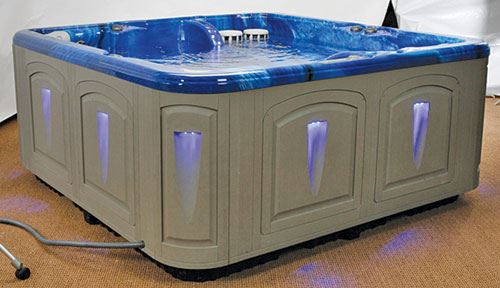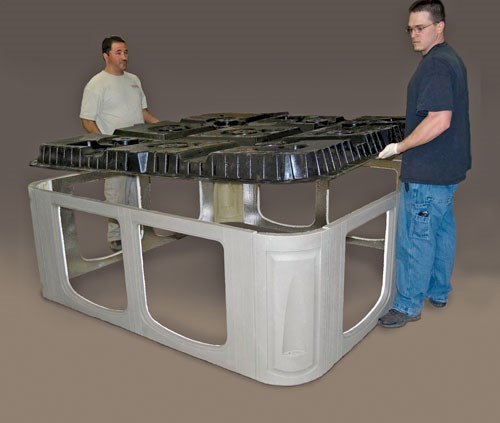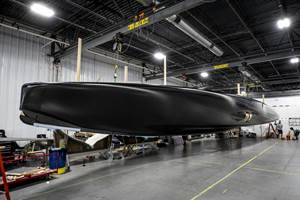Polyurethane long fiber technology (LFT) replaces wood in spa surround
To many consumers, the thought of a relaxing soak in a hot tub is mighty appealing — but the thought of spa maintenance, particularly replacing rotted wood in the spa's cabinet-like enclosure, probably isn't. For spa manufacturer Clearwater Spas (Woodinville, Wash.), that reality and the fact that building decorativ
Share
The traditional means to hide pipes, pumps and other components, wood surrounds look great, but the required framing and assembly of numerous slats is time-consuming, and the resulting cabinetry was heavy and susceptible to the elements. Because the bulky spas had to be trucked long distances to customers, any weight savings would help in handling and transportation costs.
Clearwater first tried extruded synthetic tongue-and-groove material that, while somewhat lighter, still had to be cut to size and, as was true with the wood enclosures, the resulting components had to be attached piece by piece to a structural frame. Unfortunately, this strategy did nothing to reduce labor time and cost.
The company then turned to Bayer MaterialScience LLC (BMS, Pittsburgh, Pa.) for a molded solution. BMS suggested using a trademarked Baydur reinforced polyurethane material, specially formulated for Clearwater (one product under BMS' trademarked BaySystems polyurethane systems umbrella brand), together with a long fiber technology (LFT) molding method. Custom molder Creative Urethanes (Winchester, Va.) was selected to produce the cabinets. BMS, Clearwater and Creative Urethanes collaborated on the cabinet design, which ultimately consisted of four straight sides, each having two removable access panels (for a total of eight panels) and four rounded corner pieces, all assembled using screws or adhesive. Parts would be molded with a simulated wood grain in several colors and in several sizes to accommodate Clearwater's line of spa products — the largest side panel is 72 inches/185 cm long and 34 inches/87 cm high. Molded-in flanges would ensure that parts could be easily aligned and quickly assembled.
The LFT parts had to meet both fire standards and mechanical load-bearing requirements — in addition to offering impact, abrasion and puncture resistance. Finite element analysis (FEA) enabled designers to vary part shapes and details, such as insets for light fixtures in the access panels. Modeling that simulated the handling and transport of a spa showed that the vertical strength of Baydur LFT material easily exceeded performance requirements, even with simulated loads imposed on a side panel directly over an access panel opening.
Baydur STR is a rigid polyurethane, structural-foam material that is reinforced with 0.5-inch up to 4-inch (12.5-mm to 100-mm) long glass fibers. To make the parts, a two-part metal mold is heated to 150°F/302°C and a water-based in-mold paint film 2 to 3 mils thick (which dries to 1.5 mil thick) is applied to the mold cavity. Paint application is followed by a "barrier" spray — a two-component, 100 percent solids (i.e., no VOCs) polyurethane elastomer coating approximately 0.015 mils thick — that performs multiple functions, says Harry George, BMS' market unit head for molded parts. "The barrier spray chemically bonds the paint film to the polyurethane resin," he maintains. "It eliminates any pinholes in the final part, and it adds impact and abrasion resistance as well." Then a robotic mix head equipped with a glass chopper lays down the glass fiber while simultaneously spraying the resin mixture into the mold in a programmed pattern, a process termed open-pour. Cannon USA Inc. (Cranberry Township, Pa.) and KraussMaffei Corp. (Florence, Ky.) supply the automated mix head systems. At the end of the pour, the mold is closed to form the part. According to George, the low-pressure process takes about four minutes, "button to button."
"It's a unique, breakthrough application for spa OEMs," says George. The spa cabinet parts are strong, lightweight, chemical- and water-resistant as well as dimensionally stable, in part, because the Baydur polyurethane has a low coefficient of thermal expansion (CTE) that minimizes swell and shrink when exposed to the weather. Perhaps most important, the automated LFT molding process allows the creation of low- or high-density parts, in varying thickness and glass fiber loading, for either structural or simply decorative purposes, all with a Class A finish.
The more durable and easier-to-assemble spa enclosure saves approximately 300 lb/136 kg per spa — more then 20 percent — when compared to real wood, reports Clearwater Spas.
Company vice president Larry Richards says that the new cabinets are not only beautiful but extremely durable, ensuring that the products are delivered in the same condition they were in when they left the factory, allowing customers to concentrate on a leisurely soak.
Related Content
Belzona composite wrap restores corroded carbon steel pipeline
Two-part epoxy paste, epoxy structural adhesive, composite wrap and anti-corrosion coating prevent environmental and economic loss for customer.
Read MoreBiDebA project supports bio-based adhesives development for composites
Five European project partners are to engineer novel bio-based adhesives, derived from renewable resources, to facilitate composites debonding, circularity in transportation markets.
Read MorePittsburgh engineers receive $259K DARPA award for mussel-inspired underwater adhesion
The proposed META GLUE takes inspiration from hydrogels, liquid crystal elastomers and mussels’ natural bioadhesives to develop highly architected synthetic systems.
Read MorePro-Set named official materials supplier for New York Yacht Club American Magic
Competitive sailing team prepares for the 37th America’s Cup beginning in August 2024 with adhesives, resins and laminate testing services for its AC75 monohull construction.
Read MoreRead Next
All-recycled, needle-punched nonwoven CFRP slashes carbon footprint of Formula 2 seat
Dallara and Tenowo collaborate to produce a race-ready Formula 2 seat using recycled carbon fiber, reducing CO2 emissions by 97.5% compared to virgin materials.
Read MoreDeveloping bonded composite repair for ships, offshore units
Bureau Veritas and industry partners issue guidelines and pave the way for certification via StrengthBond Offshore project.
Read MorePlant tour: Daher Shap’in TechCenter and composites production plant, Saint-Aignan-de-Grandlieu, France
Co-located R&D and production advance OOA thermosets, thermoplastics, welding, recycling and digital technologies for faster processing and certification of lighter, more sustainable composites.
Read More



















